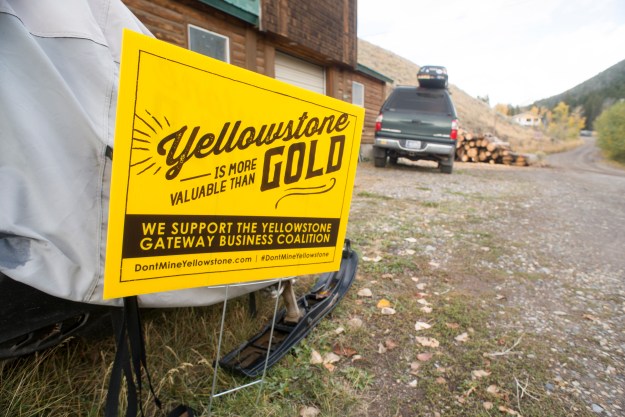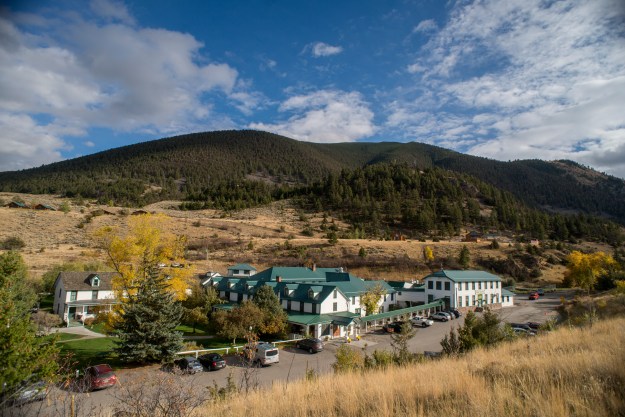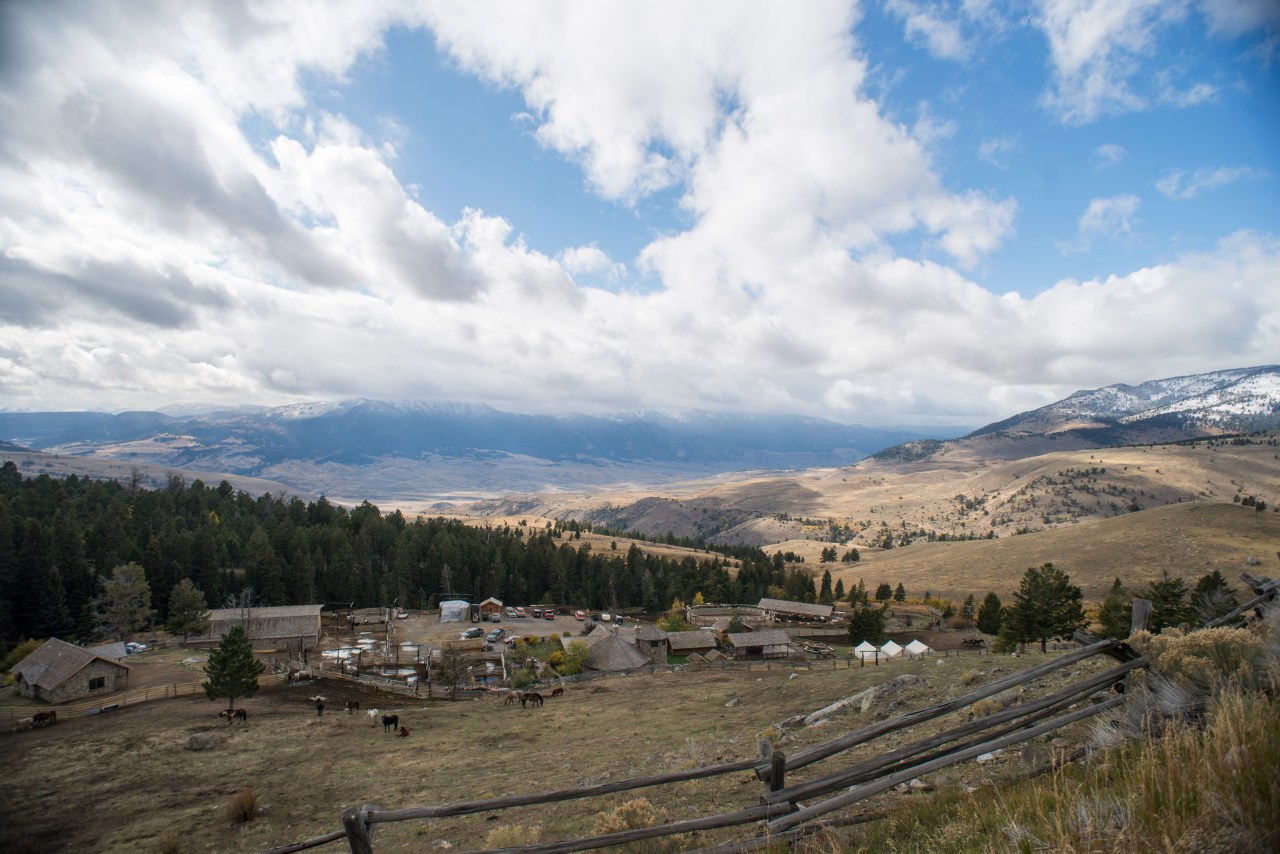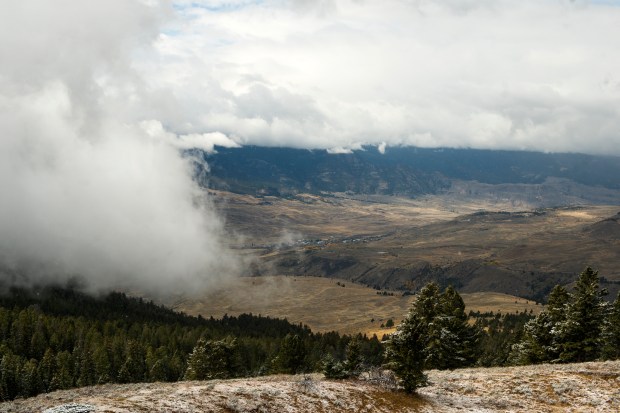“It’s gorgeous out here, it’s perfect,” Nate Mildren said at the base of a centuries-old Rocky Mountain white pine thrusting up from the Absaroka Mountains. The slope he stood on, which could have been a set piece on “The Sound of Music,” overlooked the pristine 2-million acre expanse of Yellowstone National Park.
It was early October 2016 and Mildren, 45, a real estate specialist, drove 180 miles south from Montana’s capital city, Helena, at the behest of a man named Mike Werner. Werner is a miner who wants to explore for gold on the piece of private property we stood on and neighboring national forest land on the border of Yellowstone, a place that in the previous 10 months drew more than 4 million visitors. His plan outraged both tourists and community residents alike. But in Werner’s telling, he was the aggrieved party.
“Everyone that’s being reactive is being self-centered,” Werner said, broadcast onto the mountain slope from his hometown of Spokane, Washington via the FaceTime app on my iPhone.
In late November President Barack Obama’s Secretary of the Interior, Sally Jewell, announced a temporary mining ban on roughly 30,000 acres of public national forestland around Yellowstone, effectively blocking any new large-scale mines. A hundred people cheered the announcement, made at a ceremony at the base of a mountain gulch that was a site of another new proposed gold mining operation. For more than a year, multitudes of people living below the potential mines had flown yellow signs reading “Yellowstone is More Valuable Than Gold.” The signs stretched more than 100 miles from storefronts in the city of Bozeman, through barbed wire cattle fences in the majestic and aptly-named Paradise Valley, all the way to the secluded houses in the mountain village of Jardine, on the edge of Yellowstone, where Werner has his sights set. His mines would bore into the Absaroka Mountains just above where Susan Johnson lives with her family.
“It would just ruin the ambiance of the whole area, it would be devastating for the elk and grizzly bears, we’re totally against it,” said Johnson, 59, who co-owns Hell’s A-Roarin’ Outfitters, a guide service that packs visitors into the wild backcountry on horses.
The fight isn’t over. The moratorium lasts only two years. It is scheduled to be reconsidered in 2018 by the administration of Donald J. Trump, a president whose love of gold is as subtle as that of King Louis XIV. Trump’s Secretary of the Interior, Ryan Zinke, a Republican and formerly Montana’s sole congressman, had criticized the plans to mine near Yellowstone. But he was absent from the ceremony announcing the temporary ban.
The battle over the mines is also set to reignite as the borders of America’s national parks turn increasingly into fault lines. Industries that built the old west—logging, gas drilling and mining—are colliding in an increasingly crowded region against new industries such as fly fishing, backpacking and rafting; the ecotourism economy built on the values of scenery, silence, and protection of water and wildlife.
“It’s a good microcosm of the sort of west-wide changes in demographics and values happening over the last 20 to 30 years,” said Beth Kampschror, spokeswoman for the Greater Yellowstone Coalition, one of several environmental groups opposing the mines.


In 2015 Werner submitted his gold exploration applications for Yellowstone country and a British Columbia company called Lucky Minerals did the same. Their claims rested in another part of the Absaroka Mountains just 20 miles north of the park. Speaking by phone from Canada, Shaun Dykes, vice president of Lucky Minerals, also said those opposing the mines were overreacting.
“They should look at it as there’s a potential treasure there that can be mined properly and create wealth and jobs for everybody,” he said. “Minerals have to come from somewhere.”
But community activists countered that the land’s lasting value springs from its health and scenery.
“There’s so much common sense involved in what a bad idea this is,” said Colin Davis, general manager of Chico Hot Springs Resort, which employs 170 people and welcomes guests to bathe in a geothermal pool at the base of the gulch Dykes wants to mine. (The announcement to temporarily ban the mines was made at Chico Hot Springs.)
Much of the concern over the mines stems from the fact they would sit above southeastern Montana’s aortic artery: the Yellowstone River. At 692 miles long it is the longest undammed stream in the contiguous U.S. It provides vital water for wildlife, agriculture, and towns in Wyoming, Montana, and North Dakota.
Decades earlier, Absaroka mountain mines became tapped out of all easily accessible gold, plus silver, lead, and arsenic used for agricultural pesticides, historic reports show. Geologists say the only remaining gold in these mountains, which rose as volcanoes some 50 million years ago, would lie deep under their surface. So would iron sulfide. Mixed with rain or snow, iron sulfide becomes sulfuric acid. The toxin now leaks from many of Montana’s estimated 20,000 historic mines.
There’s so much common sense involved in what a bad idea this is.
Both Werner and Dykes say all environmental threats could be mitigated with new technology. They imagine any industrial mining would be done underground via surgical-like bores. The surface, save chopping some trees and widening dirt roads, would be left as untouched as possible. Ore would be processed at a remote location, as a courtesy to the community, by having convoys of dump trucks haul millions of tons of extracted rock away via the two-lane highway leading from Yellowstone. River pollution wouldn’t be an issue, they said, because of the angles of the mine shafts.
“It’s not going to happen because it hasn’t happened,” Werner said.
He speaks from experience. Werner worked for the last company to mine gold in Jardine. Called TVX Mineral Hill Inc., it closed in 1996. That evidence of some of their and other nearby abandoned mines—rusted strips of rail, sluice ditch gouges, and collapsed entrances—are now regrown with Douglas fir trees, snowberry bushes and wild roses is partially their doing. The federal Bureau of Land Management in 2011 gave TVX an award for outstanding mine cleanup work.
According to the Montana Department of Environmental Quality, however, between 1996 and 1999 TVX was cited three times for environmental violations at the Mineral Hill site. Once for digging an unauthorized pit. Again for allowing too many nitrates into the groundwater. And a third time for piping mine drainage into a creek that pours through the national park and into the Yellowstone River.
“Another threat could throw the balance completely in the wrong direction,” said Max Hjortsberg, of the Park County Environmental Council. “It’s a very sensitive ecosystem.”
Some fear the balance has already tipped. Lower in the Yellowstone River in 2011, and again in 2015, pipelines burst and spilled more than 93,000 combined gallons of crude oil. Then in August 2016, an invasive spore killed an estimated 40,000 mountain whitefish in the Paradise Valley. As an emergency precaution, the state closed 183 miles of the Yellowstone River to all recreation. As the stench of dead fish on valley winds at peak tourist season emphasized the river’s fragility, University of Montana economists estimated the cost to businesses in Park County might have topped $500,000.

A tug-of-war between earnest preservationists and wily industrialists has strained Yellowstone country since the 1860s when the first mines were staked on what was legally Crow Indian land. Brawny prospectors and crafty investors were rewarded by the mines, which Gilded Age humorist Mark Twain is said to have defined then as, “a hole in the ground owned by a liar.”
Yellowstone was proclaimed the world’s first national park in 1872. In the 1890s, outlaws from the rough-hewn mining town of Cooke City, Montana raided across Yellowstone’s northeast border and poached all but a known 23 of the last remaining wild buffalo in America. Simultaneously, the town’s namesake, financier Jay Cooke, lobbied the U.S. Congress to shrink Yellowstone by one-third so he could build another mining railroad. He almost succeeded.
“Mining had enormous influence here,” says park historian, Lee Whittlesey.
Early environmentalist John Muir sounded a different call. In his 1898 Atlantic Magazine article celebrating Yellowstone, Muir also wrote of the Absarokas being, “mountain mansions so rare.” In 1903 President Theodore Roosevelt signaled his agreement as he dedicated a stone archway that now bears his name at Yellowstone’s northwest entrance. Roosevelt, who protected the national forests around Yellowstone, urged the hundreds of community members who gathered around him at the arch dedication ceremony to forever be, “jealously safeguarding and preserving the scenery.”
By the early 1980s, mining was in deep decline across Montana. Taxpayer-subsidized cleanups of abandoned, toxic mines offset the mineral wealth that had been produced—and mostly siphoned to out-of-state executives. “It is a cruel fact that no simple cheap way exists to clean up old mines,” environmental historian Jared Diamond wrote in his 2005 book “Collapse: How Societies Choose to Fail or Succeed.” In 1983 came the shutdown of the enormous open-pit copper mine 110 miles from Yellowstone in the city of Butte. Those mines once made Montana one of the richest states in the nation. Today they constitute the largest federal toxic superfund site.
Still, the tug-of-war raged. In the late 1980s President Ronald Reagan vetoed a bill that would have stopped new mines around Yellowstone after advisers told him the move could help the Republican Party pick up a Senate seat (Montana’s then Democratic senator John Melcher, who supported the mining bans, was defeated in 1988 by Republican Conrad Burns, who didn’t.) In the late 1990s, President Bill Clinton used the embattled Land and Water Conservation Fund to retire private claims around Cooke City and clean old mines leaking acid down through the park and into the Yellowstone River. The water cleanup dovetailed with a surge in anglers wanting to fly-fish in pristine waters for trout, as popularized by the 1992 film “A River Runs Through It”—partially filmed near Yellowstone. The number of raft companies plying the cleaner Yellowstone River then doubled, according to data from a local chamber of commerce.
Exploration doesn’t stop until someone gives up…It’ll arise until you and I are long dead.
When TVX closed the last industrial mine near Yellowstone after the gold market plunged in 1996, it was a hard economic blow for Park County. Some 120 jobs paying around $60,000 a year vanished, state officials said. But census data shows a striking rebound. As the county population grew by 1,500 over the next 20 years, businesses rose from fewer than 500 to close to 800 and the number of employed adults climbed from less than 7,000 to more than 10,000. Also, average home values more than quadrupled from less than $49,000 to more than $210,000 as the spectacular landscape drew retirees and celebrities. And Per capita income in 2015 had grown to near $26,000; less than the national average of $28,555, but more than double the county’s per-capita income when mines were active.
Meanwhile, Yellowstone visitation grew by a million. Now the region reaps an estimated half-billion dollars a year from nature tourism. In 2015 the Kauffman Foundation, which monitors start-up activity in each state, ranked Montana at the top in new business creation. Economists speculated that entrepreneurs were attracted by the awesome outdoors.
“These mines don’t match the economic drivers,” said Michelle Uberuaga, executive director of the Park County Environmental Council.
At November’s mining moratorium announcement Montana’s Democratic senator Jon Tester—the only farmer in the U.S. senate—said he would introduce legislation to make it permanent. Though Rep. Zinke was absent, two months later at his congressional confirmation hearings for Secretary of the Interior, he said he was inspired by Theodore Roosevelt. It underscored the value of Yellowstone country as a place pure enough to sustain both endangered grizzly bears and political bipartisanship.
But Dykes and Warner are undaunted. They still intend to explore for gold near Yellowstone on small private lands and claims that fall under state jurisdiction, not federal. The Montana Department of Environmental Quality gave a go-ahead signal to Dykes. He said he expects to drill in the summer of 2017. Twice, however, the state ruled that Werner’s applications were deficient. He said he would resubmit.
“Exploration doesn’t stop until someone gives up,” he said. “It’ll arise until you and I are long dead.”

Of Yellowstone’s millions of annual visitors, Werner guessed that “you would probably find only 10 that would ever climb high enough to see what we do.”
A popular 2.5-mile trail in northwest Yellowstone rises up slopes speckled with sagebrush tufts where elk herds trot, threads through forests of lodgepole pines that reach into the bracing air, and eventually winds to a panoramic vista at the 8,564-foot summit of Bunsen Peak. Straight south I could see the Grand Tetons 100 miles away. When I looked north just 10 miles away I could see some of Werner’s potential gold mine sites.
The 21st century has seen conflict over proposed resort building that would threaten views from Arizona’s Grand Canyon National Park, trophy homes that mar the scenery in Utah’s Zion National Park, and oil drilling that could sully the environment around Montana’s Glacier National Park. This is Yellowstone’s battle. Relevant perspective comes from Valerie Naylor, who as superintendent of North Dakota’s Theodore Roosevelt National Park worked to save the viewshed from oil companies hydraulic fracturing all around for natural gas.
“It’s the role of the public to speak out to save those views,” she said. “They’re why people come to a national park.”